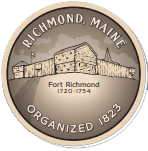Richmond Tax Increment Financing (TIF) Districts
Richmond’s Tax Increment Financing (TIF) Districts
The Town of Richmond has two Tax Increment Financing (TIF) Districts. The Downtown TIF was created in 2005 and remains in effect until 2030. The Pipeline/Compressor Station TIF was adopted in 2000 and is in effect until 2020.
What is a TIF?
Tax increment financing districts, or TIFs, are an economic development tool whereby new property taxes generated by new business investment can be used to encourage further business investment and assist in job creation and job retention. In a designated TIF district, property values within the district are frozen. When improvements are made within the district and value increases, the difference between the frozen value and the new value is called the “captured value,” and property taxes generated by that captured value are used to support the development project. In 1993, an amendment to the TIF statute allowed credit enhancement agreements (CEAs). CEAs permit the “captured” property tax dollars to be directed to the business doing the development.
A TIF district is a specific geographic area identified for commercial growth and expansion, or an area identified as blighted and in need of rehabilitation. A Development Plan is created that outlines the project objectives and public purpose. A Financial Plan details the financing mechanism for the improvements, the duration of the program, and how the revenues from the captured valuation are to be used.
When a town realizes an increase in valuation created by a new investment it also experiences a reduction in its share of state revenues and an increase in county taxes. Through its TIF districts, Richmond shelters the new valuation from the calculations of state revenue sharing, education subsidies and county tax assessments. Sheltering this new property value within a TIF district avoids the reduction in state revenue sharing and education subsidy and increases in county taxes due to the investment.
TIFs are a creature of state law and are administered by Maine’s Department of Economic Development (DECD) and the details must be approved by the DECD. TIFs have existed in Maine law since 1977, although municipalities showed little interest in the program until the mid-1980s; TIFs are growing in popularity and many other towns in the region are currently in the process of adopting new districts.
Downtown TIF
In 2004, the Town of Richmond adopted the “Richmond Village Downtown Revitalization Plan” (HYPERLINK) (updated in 2011), which identified specific community goals for improving the downtown and riverfront. One of the resources identified to implement this plan was the creation of a Downtown TIF, as a way to support existing community development objectives in the following ways:
- Promote long-term sustainable employment opportunities for area residents;
- Capitalize on the town’s proximity to major highway routes as well as the Kennebec River;
- Create a more pedestrian friendly and accessible downtown;
- Establish a gateway to the town;
- Redevelop, restore and enhance buildings with historic significance within the village;
- Revitalize Fort Richmond Park;
- Upgrade town infrastructure including sidewalk improvements, rerouting overhead utilities, creation of additional parking, and establishing more green space in the community; and
- Redevelop older properties in the downtown area.
In March 2005 the Maine Department of Economic & Community Development (DECD) reviewed and approved the Town of Richmond’s designation of the Downtown Municipal Development Tax Increment Financing (TIF) District (“the district”). The district designation remains in effect for twenty-five (25) years (2030) or until the authorized project costs are expended. The total acreage of the Downtown TIF District is 101.5 acres, .56% of the total acreage of the Town of Richmond. (Map, HYPERLINK)
Since the creation of the Downtown TIF District, many of the above objectives have been met, such as redeveloped and enhanced historic buildings, upgraded infrastructure, a more pedestrian friendly downtown, and improvements to Fort Richmond Park (“the Waterfront”). A significant contribution of capital investment in the community has also been made by several private business owners and the Maine DECD.
Several downtown initiatives proposed in the Downtown Revitalization Plan could be implemented with TIF revenues and public/private investment, including:
- Implementation of the Downtown Parking Master Plan (Hyperlink?).
- Continued implementation of bicyclist/pedestrian infrastructure, including the state-approved Richmond Village Merrymeeting Trail.
- Village gateway and way-finding signage.
- Restoration of downtown historic buildings, such as the Hathorn Building on the corner of Main and Front Street.
Pipeline/Compressor Station TIF
The Pipeline/Compressor Station TIF was approved at 2000 Town Meeting and is in effect for 20 years (expires in 2020).
The Development Program for this TIF includes:
- Creation of an economic development revolving loan fund which will support job creation and retention activities and support investment in taxable property in town (for more information about the Town’s revolving loan fund, see here (LINK).);
- Staffing a municipal economic development department which will work directly with the Town Manager, Selectmen and Economic and Community Development Committee;
- Administrative costs of this Development Program and organizational costs of the District;
- The development and implementation of plans designed to support and enhance economic development efforts;
- Support development of municipal and privately owned commercial and industrial facilities in town to attract new business; and
- Improve/increase public infrastructure and amenities in town.
The Town of Richmond may use these TIF funds for direct investment for the following activities on private property to encourage the reuse of dilapidated structures or properties:
- Evaluation of commercial structures
- Façade improvements
- Public parking
- Site work
- Internal building improvements and/or structural improvements
- Acquisition and sale of real and personal property for economic development purposes
If you have any question about the Town of Richmond TIF Districts, please contact Darryl Sterling at (207)737-4305 x331 or email [director@richmondmaine.com].
